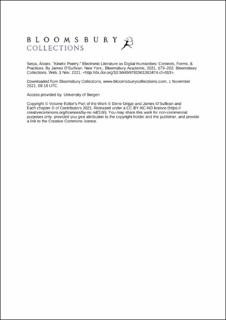| dc.description.abstract | This chapter proposes a brief history of kinetic poetry as a transmedia and cross-artistic form. It connects the most relevant threads of a possible historiographic narrative of how kinetic poetry has been evolving since the beginning of the twentieth century at the intersection of literature, visual arts, cinema, animation, and technology, across various media. It argues for a transmedia approach because it does not place kinetic poetry at the heart of computational media and as a digital literature-specific genre, but rather as a temporal form that is media and language-specific, but also culturally and politically situated. Kinetic poetry is a form of poetry that relies on spatiotemporal transitions with expressive literary, visual and aural layers. Throughout the twentieth century, authors composed kinetic poems with varied media, such as motorized sculptures, celluloid film, video, holography, and computers. As it is unveiled, the origins of kinetic art and kinetic poetry can be traced back to the Constructivists’ Realisticheskii Manifest and the Dadaists’ praxis. When Marcel Duchamp staged puns via rotoreliefs in the 35 mm film Anémic Cinéma (1926), he opened up the way for hybrid works that can be experienced through the lenses of cinema, textual art in motion, and kinetic poetry. Later on, language went from projection to interaction, first with the investigations by the experimental poets in the 1950s-80s and then with the explorations by the digital poets from the 1980s onwards. Therefore, the discussion of kinetic poetry’s cultural and technological history goes back to early abstract films, mechanical poetry, film poetry, videopoetry, holopoetry, to finally present algorithmically programmed animation. Because this narrative is heavily Euro- and American-centric, this chapter invites readers to contest the following historiographic version of kinetic poetry’s trajectory, and to share knowledge about works created in other latitudes, especially by women and non-white authors. | en_US |

